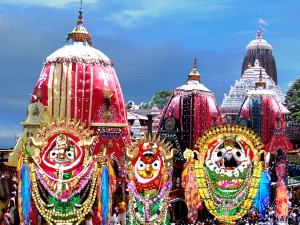The festivals of the temple draw huge crowds not only from Odisha but also from other states of India. The festivals are, no doubt, occasions of great religious experience and devotional fervour but they are also occasions for trade, industry, commerce and business activities in Puri.
A festival in this connection is known as a ‘Yatra’, which simply means a visit. Some of the most important festivals are as follows:
Chandana Yatra :
This festival takes place in the month of Vaisakha and continues for 21 days. But technically speaking, it is a festival of long 42 days.The rites observed on the other 21 days are simple and less significant. In the first half period of 21 days, the representative images of the god are taken in a procession to the famous tank called Narendra Pokhari. They are taken round the tiny lake in beautifully decorated and illuminated boats twice each day. Thousands of people enjoy the festival with great delight.
Snana Yatra:
This festival takes place  in the full moon day in the month of Jyestha, popularly known as the Deva Snana Purnima. This – is the first occasion in the course of a year when the wooden images of the three principal deities of the Puri temple, are brought out of the sanctum sanctorum in a procession and placed on the Snana Vedi . (described earlier) and are bathed with 108 pitchers of water. The usual daily rituals continue thereafter in the Snana Vedi. On this occasion Jagannatha and Balabhadra are dressed like Ganesa with the head of an elephant. From the Deva Snana Purnima till the second day of bright Asadha, the deities are not to be seen on the ‘Ratnavedi’ in the sanctum. They are worshipped secretly. Preparations for the Car Festival would be in progress and the deities would be seen only for a few hours before they are taken out of the temple to participate in the Car Festival.
in the full moon day in the month of Jyestha, popularly known as the Deva Snana Purnima. This – is the first occasion in the course of a year when the wooden images of the three principal deities of the Puri temple, are brought out of the sanctum sanctorum in a procession and placed on the Snana Vedi . (described earlier) and are bathed with 108 pitchers of water. The usual daily rituals continue thereafter in the Snana Vedi. On this occasion Jagannatha and Balabhadra are dressed like Ganesa with the head of an elephant. From the Deva Snana Purnima till the second day of bright Asadha, the deities are not to be seen on the ‘Ratnavedi’ in the sanctum. They are worshipped secretly. Preparations for the Car Festival would be in progress and the deities would be seen only for a few hours before they are taken out of the temple to participate in the Car Festival.
Ratha Yatra:
The Ratha Yatra of Jagannatha is commonly known as Car Festival. It is also known as Gundicha Yatra. According to the tradition current in Odisha, Gundicha was the name of the queen of Indradyumna, the legendary builder of the first temple. As Gundicha had initiated this festival, it is known after her name.This festival of international fame takes place in the month of Asadha (June – July) every year. It is a nine-day festival, when the deities are taken to the Gundicha temple located at a distance of about 3 kms. from the main temple along the Grand Road in three gorgeously decorated chariots, specially made for each of the three deities. Normally, the chariots reach the destination (the Gundicha temple) by the evening on the first day of the festival and onthe ninth day, the deities are brought back to the main temple on the same chariots.
Thus, the deities practically spend full seven-days in the Gundicha temple.
The return journey is called Bahuda Yatra and is performed on the
samemanner ,as Ratha Yatra.Certain other religious rites are performed
on the chariots on that day including special dressing of the deities after
which the deities are taken back to .the sanctum sanctoram. Logs of wood
for the chariots are obtained from the forests of Dasapalla located at a
distance of about 200 kms. from Puri The chariots are dismantled after
the festival is over. The special names of these three chariots are as
follows : (i) Jagannatha – Nandighosa,'(ii) Balabhadra Taladhvaja and
(iii) Subhadra – Devadalana. The colourof the fabrics used to decorate the
chariots are yellow, green and black respectively, mixed with red.
The order of movement of the chariots from the temple gate towards the Gundica temple are (a) Balabhadra,(b)Subhadra and lastly, (c) Jagannatha. The deities are taken from the temple to the chariots in a swinging manner, which is locally called Pahandi. They are made to swing forward and backward in the process of which there is a little forward movement in each effort. After the deities are seated on their respective chariots, the Raja of Puri sweeps the floor of the chariots (locally called Chera Pahanra) and this is a great attraction during the Ratha Yatra. This signifies that even the highest sovereign power of the country is only a servant , before the God. After the sweeping ceremony is over, the charioteers are seated on the respective chariots, the horses (four in each chariot) are tied and the ropes (usually four in each chariot) are fitted. A huge log is used as the break of each chariot. Then the people are allowed to pull the chariots in .the order mentioned earlier, irrespective of caste, creed, sect, religion and sex distinctions. This liberty indicates that the god is equal for every person on earth and grants equal opportunity to all. This festival also signifies that, the deities desire to come down to the level of the common people for some time and move with them. It is said that Gundica temple was the place where Jagannatha had his first manifestation in the present form and therefore, it is the birth place of Jagannatha.
Sayana Ekadasi :
This festival takes place in the month of Asadha, when the deities are still in their chariots in the Lions Gate after the Return Car Festival. On this occasion, the images of Vasudeva, Bhubanesvari and Narayana are taken to the chariots. After some rites are performed there, these images are taken to the ‘chamber of slumber’ for enjoying complete rest for four months.
Daksinayana Sankranti:
This festival takes place on the day of Karkata Sankranti. Special rites are performed on. this occasion.
Parsva Parivartana Ekadasi:
This festival takes place in the month of Bhadra. The deities enjoying sleep change sides on this day.
Deva Utthapana Ekadasi:
This festival takes place in the month of Kartika. On this day the deities rise from their sleep. Besides, it is a very sacred day for the Hindus. Parvana Sasthi: This festival takes place in the month of Margasira. This is locally known as Odhana Sasthi. The deities are covered with thick cloths till the month of Magha.
Dola Yatra:
This festival takes place in the month of Phalguna. The representative Deities are taken in a procession to a dias called Dolavedi located outside the main temple and special rituals are performed.
Damanaka Chaturdasi :
This festival falls in the month of Caitra. On this day, the deities pay a visit to the celebrated garden of Jagannatha Vallabha Matha, where they pick up the tender leaves of the Dayana plant un-noticed by anybody and put them on.
Makara Sankranti:
This festival falls in the month of Pausa. The deities are specially dressed on this occasion. Boiled rice mixed with candy and the juice of some fruits is offered to the deities. This festival has some agricultural significance.
Pusyabhiseka :
This festival falls on the full moon day of the month of Pausa and deities put on royal dress on this occasion.
Niladrimahodaya:
This festival falls in the month of Vaisakha, when special rites are performed.
Apart from these important festivals, there are about 50 more festivals that are observed with great enthusiasm in an atmosphere of profound religious fervour. Some of these are :
- Jhulana Yatra – Swing festival for seven days.
- Sola Puja – Special esoteric worship in the Vimala temple for sixteen days.
- Rama Navami – Birth of Rama incarnation.
- Kumara Purnima. Janmastami – Birth of Krisna.
- Krisna Lila – The exploits of Krisna.
- Ganesa Caturti – Birth of Ganesa.
- Radha-Astami – Birth of Radha.
- Vamana Janma (or Sunia) – Birth of Vamana.
- Ananta Caturdasi – Birth of Ananta.
- Dwitiya Osa – This is specially observed in the temple of Laksmi. In Odisha ‘Osa’ means religious fasting.
- Dasahara – Takes a way ten sins.
- Navanna – Taking of new food.
- Dipawali- Offering of lamps to forefathers.
- Prathamastami.
- Vakula Amavasya.
- Sri Pancami – Special worship of Sarasvati.
- Sivaratri Sacred day for Siva.
- Asokastami.
- Maha Visuva Sankranti – Also known as Pana Sankranti in Odisha. Pana means sweet drink.
- Nrusingha Janma -Birth of Nrusingha.
- Sitala Sasthi – Marrige of Siva.
- Rukmini Harana Ekadasi – Marrige of Krishna
- Details on these may be locally collected.

